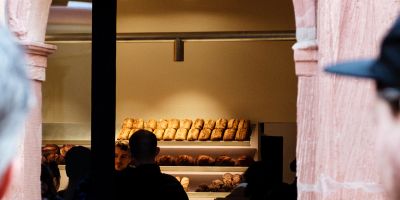Your Cart is Empty
New seminar dates every first friday of the month! // Free international shipping available
New seminar dates every first friday of the month! // Free international shipping available
Kurse & Seminare
About Us

San Gabriel - Coffee cultivation in Colombia in the light of social change
July 25, 2022 4 min read
San Gabriel - under this name we present an Orange Tabi is an outstanding example of a coffee from Colombia's Huila province. Typically, coffee in Huila is prepared washed and this also helps this Orange Tabi to form a clear and clean cup profile. Typical of a Colombian coffee are the tangy fruit acids, whose sublime sweetness interacts with more settled notes of cocoa to create a round and balanced cup.

Coffee farming in Colombia - current issues and responses
Coffee farming in Colombia has long since ceased to be the strong industry it once was. While export volumes are undeniably high, its share of gross domestic product has steadily declined and nowadays ranges from 10% to 16%. At the same time, the average age of coffee farmers in Colombia has been rising for some time, and in 2018 was 49 years old in the Huila region, where Finca San Gabriel is located - the data all point to the fact that Colombian coffee farming has a youth problem. Colombia is by no means alone among coffee-producing countries in this regard, as it is a tough business: price fluctuations, global climate change and the resulting diseases affecting the coffee plant are making life difficult for coffee farmers worldwide. It's only understandable that the next generation is drawn to other fields.
In order to make the future of Colombian coffee farming a little more promising, Colombian coffee farmers organized themselves into the FNC (Federácion Nacional de Cafeteros) as early as 1927. Due to the still very large share of coffee cultivation in the country's total economic output, the FNC enjoys great influence up to the higher political circles and tries to help shape the future of coffee cultivation in Colombia. Against the current backdrop, the FNC has developed a strategy paper that seeks to make coffee cultivation more attractive in the decade between 2020 and 2030.

Mass or class?
Practically, there are two common starting points for Colombian coffee farmers to set up their business. The traditional approach is to achieve high utilization per hectare at the lowest possible financial cost. The coffees grown in this way are traded on the world market under the name "Columbian Milds". Although farmers operating in this way have less financial outlay for their production, they are dependent on the mechanisms of the global coffee trade, which are very difficult to control, and are therefore very susceptible to price fluctuations. The modern approach, on the other hand, is to go for class instead of mass: using elaborate techniques, the aim is to achieve the highest possible quality of the coffee - measured by cupping scores, which are common pricing techniques in specialty coffee. Although farmers who proceed in this way have to put in more effort, they are also rewarded with significantly higher prices and, also due to ever-increasing knowledge, have significantly more control over the most important lever of their product - the quality.
The FNC's policy paper encourages farmers, via the provision of financing and know-how, to adopt the second approach in order to be able to achieve higher profits. Generational changes are often a critical moment in this regard, because when the farm passes from parents to children, they are often more likely to inspire change. This is what happened at Finca San Gabriel when Graciela Rodriguez Ospina took control. To produce higher qualities, she planted new varieties - including the Orange Tabi, as we present to you.
Strengthening the female workforce
But it's not just prioritizing higher quality that makes Graciela a progressive farmer. With her conscious decision to let women play the main role on her farm, she is bucking long-established and entrenched role models that remain strongly rooted in Colombian coffee farming. Typically, Colombia's coffee farms are family businesses with a man at the helm. The general view of these businesses remains very traditional. While the men at the top are often presented as caring authorities who keep an eye on the whole business, including the larger family concerns, and above all, work hard and model to their children how best to care for the fragile nature of the farm, women in coffee farming are mostly seen as playing the role of caring supporters - performing important social tasks within the farm and the wider community, but being no more than the executive hand of the knowledgeable man in the field. In practice, this rigid gender image often leads to difficult access for women to funding and knowledge when it comes to their own projects, because their traditional role doesn't actually provide for any need for such needs - Graciela's aggressively delivered message that women can do every step of the production chain at least as well as their male counterparts is thus a much-needed statement in a field where predominantly male self-perceptions and reality are not in sync.
Colombia's coffee cultivation has always been characterized by being diverse, changeable, and actively seeking to respond to threats. It is not for nothing that, in the face of major environmental problems, the FNC created the Cenicafé Research Institute, an institution dedicated to the crossing of new varieties and to which such notable varieties as Castillo, or indeed Tabi, can be traced, both of which were targeted for resistance to crop-threatening botanical diseases. A generation later, the problem has diversified: the threats facing Colombian coffee cultivation are no longer identified exclusively in botanical and ecological fields, but increasingly in the social context of Colombian coffee cultivation. That's why farms like Finca San Gabriel, led by Graciela Rodriguez Ospina, are now trying to find their own answers to new socioeconomic questions.
Join our Coffee Crew
10% discount on your first coffee order.And more: Sign up for our newsletter and never miss coffee releases, offers and background stories again.

Never miss out on great coffee again!
A new, freshly roasted coffee delivered to your home every month? Whether you prefer filter or espresso, our coffee subscription takes you on a regular sensory world tour through the world of coffee — with free worldwide shipping!



















